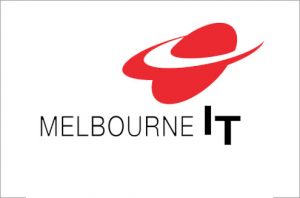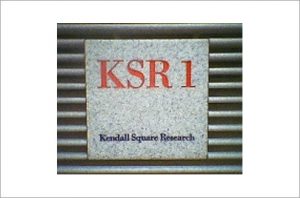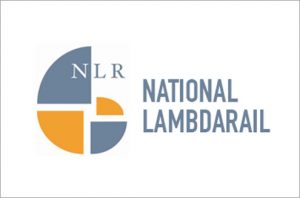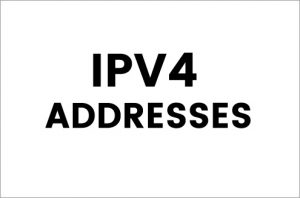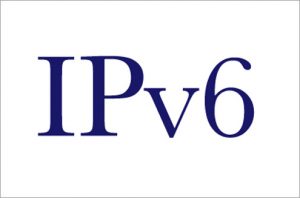Internet Protocol version 6 (IPv6) is the most recent version of the Internet Protocol (IP), the communications protocol that provides an identification and location system for computers on networks and routes traffic across the Internet. IPv6 was developed by the Internet Engineering Task Force (IETF) to deal with the long-anticipated problem of IPv4 address exhaustion. IPv6 is intended to replace IPv4.
Every device on the Internet is assigned a unique IP address for identification and location definition. With the rapid growth of the Internet after commercialization in the 1990s, it became evident that far more addresses would be needed to connect devices than the IPv4 address space had available. By 1998, the Internet Engineering Task Force (IETF) had formalized the successor protocol. IPv6 uses a 128-bit address, theoretically allowing 2128, or approximately 3.4×1038 addresses. The actual number is slightly smaller, as multiple ranges are reserved for special use or completely excluded from use. The total number of possible IPv6 addresses is more than 7.9×1028 times as many as IPv4, which uses 32-bit addresses and provides approximately 4.3 billion addresses. The two protocols are not designed to be interoperable, complicating the transition to IPv6. However, several IPv6 transition mechanisms have been devised to permit communication between IPv4 and IPv6 hosts.
IPv6 provides other technical benefits in addition to a larger addressing space. In particular, it permits hierarchical address allocation methods that facilitate route aggregation across the Internet, and thus limit the expansion of routing tables. The use of multicast addressing is expanded and simplified, and provides additional optimization for the delivery of services. Device mobility, security, and configuration aspects have been considered in the design of the protocol.
IPv6 addresses are represented as eight groups of four hexadecimal digits with the groups being separated by colons, for example 2001:0db8:0000:0042:0000:8a2e:0370:7334, but methods to abbreviate this full notation exist.
Main features
IPv6 is an Internet Layer protocol for packet-switched internetworking and provides end-to-end datagram transmission across multiple IP networks, closely adhering to the design principles developed in the previous version of the protocol, Internet Protocol Version 4 (IPv4). IPv6 was first formally described in Internet standard document RFC 2460, published in December 1998.
In addition to offering more addresses, IPv6 also implements features not present in IPv4. It simplifies aspects of address assignment (stateless address autoconfiguration), network renumbering, and router announcements when changing network connectivity providers. It simplifies processing of packets in routers by placing the responsibility for packet fragmentation into the end points. The IPv6 subnet size is standardized by fixing the size of the host identifier portion of an address to 64 bits to facilitate an automatic mechanism for forming the host identifier from link layer addressing information (MAC address). Network security was a design requirement of the IPv6 architecture, and included the original specification of IPsec.
IPv6 does not specify interoperability features with IPv4, but essentially creates a parallel, independent network. Exchanging traffic between the two networks requires translator gateways employing one of several transition mechanisms, such as NAT64, or a tunneling protocol like 6to4, 6in4, or Teredo.
Motivation and origin
IPv4
Internet Protocol Version 4 (IPv4) was the first publicly used version of the Internet Protocol. IPv4 was developed as a research project by the Defense Advanced Research Projects Agency (DARPA), a United States Department of Defense agency, before becoming the foundation for the Internet and the World Wide Web. It is currently described by IETF publication RFC 791 (September 1981), which replaced an earlier definition (RFC 760, January 1980). IPv4 included an addressing system that used numerical identifiers consisting of 32 bits. These addresses are typically displayed in quad-dotted notation as decimal values of four octets, each in the range 0 to 255, or 8 bits per number. Thus, IPv4 provides an addressing capability of 232 or approximately 4.3 billion addresses. Address exhaustion was not initially a concern in IPv4 as this version was originally presumed to be a test of DARPA’s networking concepts. During the first decade of operation of the Internet, it became apparent that methods had to be developed to conserve address space. In the early 1990s, even after the redesign of the addressing system using a classless network model, it became clear that this would not suffice to prevent IPv4 address exhaustion, and that further changes to the Internet infrastructure were needed.
The last unassigned top-level address blocks of 16 million IPv4 addresses were allocated in February 2011 by the Internet Assigned Numbers Authority (IANA) to the five regional Internet registries (RIRs). However, each RIR still has available address pools and is expected to continue with standard address allocation policies until one /8 Classless Inter-Domain Routing (CIDR) block remains. After that, only blocks of 1024 addresses (/22) will be provided from the RIRs to a local Internet registry (LIR). As of September 2015, all of Asia-Pacific Network Information Centre (APNIC), the Réseaux IP Européens Network Coordination Centre (RIPE_NCC), Latin America and Caribbean Network Information Centre (LACNIC), and American Registry for Internet Numbers (ARIN) have reached this stage. This leaves African Network Information Center (AFRINIC) as the sole regional internet registry that is still using the normal protocol for distributing IPv4 addresses.
Working-group proposals
By the beginning of 1992, several proposals appeared for an expanded Internet addressing system and by the end of 1992 the IETF announced a call for white papers. In September 1993, the IETF created a temporary, ad-hoc IP Next Generation (IPng) area to deal specifically with such issues. The new area was led by Allison Mankin and Scott Bradner, and had a directorate with 15 engineers from diverse backgrounds for direction-setting and preliminary document review: The working-group members were J. Allard (Microsoft), Steve Bellovin (AT&T), Jim Bound (Digital Equipment Corporation), Ross Callon (Wellfleet), Brian Carpenter (CERN), Dave Clark (MIT), John Curran (NEARNET), Steve Deering (Xerox), Dino Farinacci (Cisco), Paul Francis (NTT), Eric Fleischmann (Boeing), Mark Knopper (Ameritech), Greg Minshall (Novell), Rob Ullmann (Lotus), and Lixia Zhang (Xerox).
The Internet Engineering Task Force adopted the IPng model on 25 July 1994, with the formation of several IPng working groups. By 1996, a series of RFCs was released defining Internet Protocol version 6 (IPv6), starting with RFC 1883. (Version 5 was used by the experimental Internet Stream Protocol.)
It is widely expected that the Internet will use IPv4 alongside IPv6 for the foreseeable future. Direct communication between the IPv4 and IPv6 network protocols is not possible; therefore, intermediary trans-protocol systems are needed as a communication conduit between IPv4 and IPv6 whether on a single device or among network nodes.
Comparison with IPv4
On the Internet, data is transmitted in the form of network packets. IPv6 specifies a new packet format, designed to minimize packet header processing by routers. Because the headers of IPv4 packets and IPv6 packets are significantly different, the two protocols are not interoperable. However, in most respects, IPv6 is an extension of IPv4. Most transport and application-layer protocols need little or no change to operate over IPv6; exceptions are application protocols that embed Internet-layer addresses, such as File Transfer Protocol (FTP) and Network Time Protocol (NTP), where the new address format may cause conflicts with existing protocol syntax.
Larger address space
The main advantage of IPv6 over IPv4 is its larger address space. The length of an IPv6 address is 128 bits, compared with 32 bits in IPv4. The address space therefore has 2128 or approximately 3.4×1038 addresses.
In addition, the IPv4 address space is poorly allocated; in 2011, approximately 14% of all available addresses were utilized. While these numbers are large, it was not the intent of the designers of the IPv6 address space to assure geographical saturation[clarification needed] with usable addresses. Rather, the longer addresses simplify allocation of addresses, enable efficient route aggregation, and allow implementation of special addressing features. In IPv4, complex Classless Inter-Domain Routing (CIDR) methods were developed to make the best use of the small address space. The standard size of a subnet in IPv6 is 264 addresses, the square of the size of the entire IPv4 address space. Thus, actual address space utilization rates will be small in IPv6, but network management and routing efficiency are improved by the large subnet space and hierarchical route aggregation.
Renumbering an existing network for a new connectivity provider with different routing prefixes is a major effort with IPv4. With IPv6, however, changing the prefix announced by a few routers can in principle renumber an entire network, since the host identifiers (the least-significant 64 bits of an address) can be independently self-configured by a host.
Multicasting
Multicasting, the transmission of a packet to multiple destinations in a single send operation, is part of the base specification in IPv6. In IPv4 this is an optional although commonly implemented feature. IPv6 multicast addressing shares common features and protocols with IPv4 multicast, but also provides changes and improvements by eliminating the need for certain protocols. IPv6 does not implement traditional IP broadcast, i.e. the transmission of a packet to all hosts on the attached link using a special broadcast address, and therefore does not define broadcast addresses. In IPv6, the same result can be achieved by sending a packet to the link-local all nodes multicast group at address ff02::1, which is analogous to IPv4 multicasting to address 224.0.0.1. IPv6 also provides for new multicast implementations, including embedding rendezvous point addresses in an IPv6 multicast group address, which simplifies the deployment of inter-domain solutions.
In IPv4 it is very difficult for an organization to get even one globally routable multicast group assignment, and the implementation of inter-domain solutions is arcane. Unicast address assignments by a local Internet registry for IPv6 have at least a 64-bit routing prefix, yielding the smallest subnet size available in IPv6 (also 64 bits). With such an assignment it is possible to embed the unicast address prefix into the IPv6 multicast address format, while still providing a 32-bit block, the least significant bits of the address, or approximately 4.2 billion multicast group identifiers. Thus each user of an IPv6 subnet automatically has available a set of globally routable source-specific multicast groups for multicast applications.
Stateless address autoconfiguration (SLAAC)
IPv6 hosts can configure themselves automatically when connected to an IPv6 network using the Neighbor Discovery Protocol via Internet Control Message Protocol version 6 (ICMPv6) router discovery messages. When first connected to a network, a host sends a link-local router solicitation multicast request for its configuration parameters; routers respond to such a request with a router advertisement packet that contains Internet Layer configuration parameters.
If IPv6 stateless address auto-configuration is unsuitable for an application, a network may use stateful configuration with the Dynamic Host Configuration Protocol version 6 (DHCPv6) or hosts may be configured manually using static methods.
Routers present a special case of requirements for address configuration, as they often are sources of autoconfiguration information, such as router and prefix advertisements. Stateless configuration of routers can be achieved with a special router renumbering protocol.
Network-layer security
Internet Protocol Security (IPsec) was originally developed for IPv6, but found widespread deployment first in IPv4, for which it was re-engineered. IPsec was a mandatory specification of the base IPv6 protocol suite, but has since been made optional.
Simplified processing by routers
In IPv6, the packet header and the process of packet forwarding have been simplified. Although IPv6 packet headers are at least twice the size of IPv4 packet headers, packet processing by routers is generally more efficient, because less processing is required in routers. This furthers the end-to-end principle of Internet design, which envisioned that most processing in the network occurs in the leaf nodes.
The packet header in IPv6 is simpler than the IPv4 header. Many rarely used fields have been moved to optional header extensions.
IPv6 routers do not perform IP fragmentation. IPv6 hosts are required to either perform path MTU discovery, perform end-to-end fragmentation, or to send packets no larger than the default Maximum transmission unit (MTU), which is 1280 octets.
The IPv6 header is not protected by a checksum. Integrity protection is assumed to be assured by both the link layer or error detection and correction methods in higher-layer protocols, such as TCP and UDP. In IPv4, UDP may actually have a checksum of 0, indicating no checksum; IPv6 requires a checksum in UDP. Therefore, IPv6 routers do not need to recompute a checksum when header fields change, such as the time to live (TTL) or hop count.
The TTL field of IPv4 has been renamed to Hop Limit in IPv6, reflecting the fact that routers are no longer expected to compute the time a packet has spent in a queue.
Mobility
Unlike mobile IPv4, mobile IPv6 avoids triangular routing and is therefore as efficient as native IPv6. IPv6 routers may also allow entire subnets to move to a new router connection point without renumbering.
Options extensibility
The IPv6 packet header has a minimum size of 40 octets. Options are implemented as extensions. This provides the opportunity to extend the protocol in the future without affecting the core packet structure. However, recent studies indicate that there is still widespread dropping of IPv6 packets that contain extension headers.
Packet format
An IPv6 packet has two parts: a header and payload.
The header consists of a fixed portion with minimal functionality required for all packets and may be followed by optional extensions to implement special features.
The fixed header occupies the first 40 octets (320 bits) of the IPv6 packet. It contains the source and destination addresses, traffic classification options, a hop counter, and the type of the optional extension or payload which follows the header. This Next Header field tells the receiver how to interpret the data which follows the header. If the packet contains options, this field contains the option type of the next option. The “Next Header” field of the last option, points to the upper-layer protocol that is carried in the packet’s payload.
Extension headers carry options that are used for special treatment of a packet in the network, e.g., for routing, fragmentation, and for security using the IPsec framework.
Without special options, a payload must be less than 64KB. With a Jumbo Payload option (in a Hop-By-Hop Options extension header), the payload must be less than 4 GB.
Unlike with IPv4, routers never fragment a packet. Hosts are expected to use Path MTU Discovery to make their packets small enough to reach the destination without needing to be fragmented.
IPv6 in the Domain Name System
In the Domain Name System, hostnames are mapped to IPv6 addresses by AAAA resource records, so-called quad-A records. For reverse resolution, the IETF reserved the domain ip6.arpa, where the name space is hierarchically divided by the 1-digit hexadecimal representation of nibble units (4 bits) of the IPv6 address.
Deployment
The 1993 introduction of Classless Inter-Domain Routing (CIDR) in the routing and IP address allocation for the Internet, and the extensive use of network address translation (NAT) delayed IPv4 address exhaustion. The final phase of exhaustion started on 3 February 2011. However, despite a decade long development and implementation history as a Standards Track protocol, general worldwide deployment of IPv6 is increasing slowly. As of September 2013, about 4% of domain names and 16.2% of the networks on the Internet have IPv6 protocol support.
IPv6 has been implemented on all major operating systems in use in commercial, business, and home consumer environments. Since 2008, the domain name system can be used in IPv6. IPv6 was first used in a major world event during the 2008 Summer Olympic Games, the largest showcase of IPv6 technology since the inception of IPv6. Some governments including the Federal government of the United States and China have issued guidelines and requirements for IPv6 capability.
In 2009, Verizon mandated IPv6 operation, and reduced IPv4 to an optional capability, for LTE cellular hardware. As of June 2012, T-Mobile USA also supports external IPv6 access.
As of 2014, IPv4 still carried more than 99% of worldwide Internet traffic. The Internet exchange in Amsterdam is the only large exchange that publicly shows IPv6 traffic statistics, which as of November 2016 is tracking at about 1.6%, growing at about 0.3% per year. As of 12 November 2016, the percentage of users reaching Google services with IPv6 reached 15.0% for the first time, growing at about 5.6% per year, although varying widely by region. As of 22 April 2015, deployment of IPv6 on web servers also varied widely, with over half of web pages available via IPv6 in many regions, with about 14% of web servers supporting IPv6.




